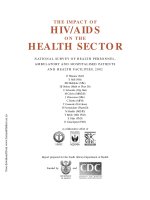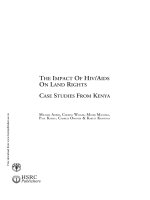THE IMPACT OF NEW MEDIA ON ACADEMIC KNOWLEDGE
Bạn đang xem bản rút gọn của tài liệu. Xem và tải ngay bản đầy đủ của tài liệu tại đây (31.35 KB, 18 trang )
AKADEMIE ZUM DRITTEN JAHRTAUSEND,
Burda Medien
Envisioning Knowledge -
from Information to Knowledge
February 3rd - 4th, 1999
Munich
THE IMPACT OF NEW MEDIA ON ACADEMIC KNOWLEDGE
Dr. A.W. (Tony) Bates,
Director,
Distance Education and Technology,
Division of Continuing Studies,
The University of British Columbia,
Vancouver, B.C.,
Canada V6T 1Z4
Tel.: (1)-604-822-1646
Fax: (1)-604-822-8636
e-mail:
Web:
© University of British Columbia, 1999
Abstract
New media, such as the Internet and CD-ROMs, are opening up new ways to deliver
education and training, especially to new markets such as those in the work-force.
However, to what extent, if at all, do these new media change the forms and nature of
knowledge? It is argued that the new media will profoundly change the nature of
knowledge, what is considered authoritative, and even on what is considered valid
knowledge. It will certainly lead to major changes in the work of teachers in higher
education. Above all, it will have profound impact on the nature of academic
organizations. These changes will not be necessarily better or worse than what exists at
present, and they will not happen quickly, but they will certainly lead to something
very different by the end of the twenty-first century.
Introduction
Developments in the Internet, in particular the World Wide Web, and developments in
multimedia technology, are resulting in new approaches to designing and developing
teaching and learning at a higher education level. Some of the characteristics of such
developments can be described as follows:
• increased flexibility and access to learning, resulting in new markets being
reached, and in particular, the lifelong learner market
• the use of multimedia to develop psycho-motor and intellectual skills
development, including problem-solving and decision-making
• the use of Internet technologies to develop knowledge management and
collaborative learning skills,
• the use of the Internet to develop global, multi-cultural courses and
programs.
As the use of such technologies become more prevalent, it is important to ask the
following questions: to what extent, if at all, will such developments change the forms
and nature of knowledge? In order to answer this question, I will describe some of the
developments at my own institution and my understanding of how these
developments relate to the question of the forms and nature of knowledge.
Using technology for teaching at the University of British Columbia
The University of British Columbia (UBC) is a typically large, publicly funded, campus-
based research institution in Canada, with approximately 35,000 students, of whom
approximately 10,000 are graduate students. It has approximately 8,000 distance
education enrolments, and has been offering distance education courses for nearly 50
years. However, the bulk of its teaching is campus-based.
Media enhancement
In the last five years, there has been a rapid growth in the number of professors at UBC
using technology as part of their teaching. Since 1994, when the university started
giving grants to support campus-based use of technology, approximately 600 projects
have been funded. Of these about 75% have been Web-based, and of the remainder,
most have been multimedia applications using a variety of development software. This
use of new technologies can be found in every Faculty and indeed in almost every
teaching department. These technologies have been used mainly to supplement face-to-
face teaching. Students access the multimedia learning materials either from campus-
based computer laboratories or increasingly from home, as a support to their face-to-
face classes, or as courses completely available in a distance format. Over 75% of all
UBC students now have an Internet account.
Technology is now used in a wide variety of ways at UBC. PowerPoint presentations
are perhaps the most common use of technology, providing clear lecture notes that
increasingly incorporate graphics and sometimes multimedia clips. Increasingly,
instructors are moving their notes to a Web database that students can access outside
the face-to-face lecture. These notes are supplemented by links to other relevant Web
sites in the subject area. Also common are course bulletin boards on the Internet, where
students and the class instructor can post their own comments, or on-line discussion
forums, where the class instructor can post questions or topics for discussion, and
students can add their own comments or ask questions. These forums are usually
asynchronous, in that each comment is added later to previous comments, although
synchronous "chat" forums may also take place when more than one person is logged
on at the same time. Lastly, a Web site may contain a list of other sites relevant to the
topic that can be accessed by clicking on the name of the site.
Developing high-level learning
Professors are also developing multimedia virtual laboratories that require learners to
examine data of various kinds and draw conclusions or solve problems. Other
multimedia developments include complex decision-making games and simulations. A
CD-ROM will contain data organized into many different variables, which are related to
each other in some way. The professor's expertise is used to estimate the effects of
changing one variable on all the others. Users are then asked to input their own data
and/or make decisions, and the software will calculate the likely outcome of such
decisions.
Distributed learning
The vast majority of applications of new technologies are used to supplement or
enhance regular classroom teaching. Slowly, though, the added flexibility and the
additional functionality of the new media are resulting in more innovative ways to
organize teaching and learning. Lectures may be reduced in numbers, students are
encouraged to work collaboratively on projects or problems outside of the classroom,
or to research sources on the Web and in the library. The instructor becomes more of a
tutor and a guide, and less the main source of information. Finally, an increasing
number of courses are being delivered entirely at a distance, using the Web and/or CD-
ROMs.
Distance education
Distance education is not new. Indeed, the University of British Columbia, which for
many years was the only university in an area the size of Germany and France
combined, has been offering undergraduate courses at a distance since 1949. Today, we
offer 124 undergraduate and graduate distance education courses in all Faculties. In the
last three years, nearly all new course development has included the World Wide Web
as a main teaching component. Increasingly, the courses are being targeted not just at
students in British Columbia but throughout the world.
There are special challenges in delivering programs throughout the world. We began
through a partnership with the Monterrey Institute of Technology in Mexico (ITESM).
They asked us to develop a set of five courses on technology-based learning that could
form part of their Masters in Educational Technology. ITESM is a large, prestigious
private university in Mexico, with 24 campuses across Mexico linked by satellite and
Internet communications.
These courses are also offered as on-line electives (optional courses) to UBC on-campus
students taking a conventional, classroom-based Masters of Education. In addition,
those who do not want to take a full masters program, or who do not want to become
a full-time graduate student at UBC, can take the courses individually. Lastly, students
can earn a post-graduate certificate from UBC if they successfully pass all five courses.
Lastly, those who do not want to do all the work for a course, for instance assignments,
can take individual courses as an audit student. However, audit students cannot obtain
a certificate.
The core of each course is its Web site (see for more
information). This is used to provide guidance on how and what to study within the
course, original text created by the instructors, links to on-line articles, journals, and
other relevant Web sites, and on-line discussion forums. The Web site also includes a
number of different online services, such as links to the UBC on-line library catalogue, a
service for getting copies of articles from the UBC Library, and advice on how to use
the Internet for research purposes. In addition, there are at least two text-books
required for each course, plus a set of printed articles bound together and mailed to
students. For the ITESM students, there are also three satellite broadcasts by the UBC
instructors per course, who are linked by dial-up video-conferencing facilities from UBC
to the satellite transmission site in Monterrey. Students submit assignments on-line, and
one feature of all courses is that at least one assignment is done collaboratively, with
three students or more from different countries working together on-line.
ITESM pays half the cost of developing the courses, and in return has the rights to offer
these courses throughout Latin America. It recruits, registers, tutors and assesses its
own students, and retains the fees from students. ITESM has been registering between
100-260 students per course.
UBC has the rights to offer the course in the rest of the world. UBC has between 25-80
students per course, with students registered in over 25 different countries, besides
Latin America. Of the first 40 students to take the courses from UBC, six already had a
Ph.D., and another 12 a Masters, in education. About 20-25% are UBC graduate
students. Most of those taking courses for non-credit are professionals working in the
field.
One of the major challenges in implementing this program was adapting the UBC's
administrative systems to meet the needs of international students. An on-line
registration system had to be developed, because the Registry did not handle non-
credit students, and the university on-line registration system could not handle
registrations for distance courses at a masters level. The university bookstore did not
have a system for tracking orders, which was critical for the international students. We
also had to work with the Finance Office to enable students to pay electronically. Lastly,
we had to re-organize the payment of fees and the delivery of materials, so that
students now receive a one-stop service. Consequently, students now pay only one fee
covering tuition and materials, and have one contact point for all services.
The program is a good example of a niche market. UBC and ITESM have identified a
fast growing area of expertise for which there is limited but specific demand on an
international scale. The target group, because of the subject matter, is more likely to
have access to the technology and to be skilled and comfortable in using it for their
studies. Because most students are already working in a professional area, they have
been able to find the money to cover the full costs of the course. Nevertheless, this









